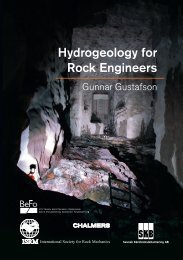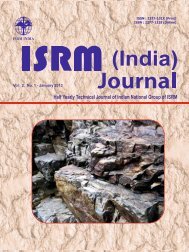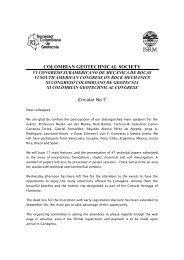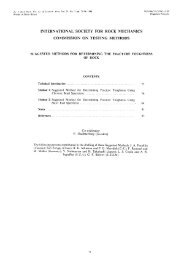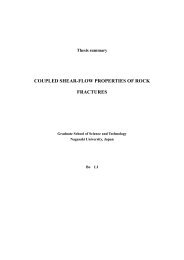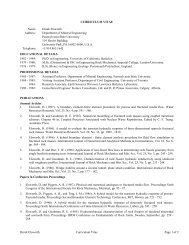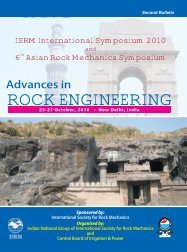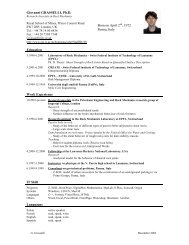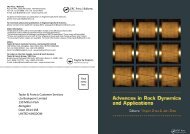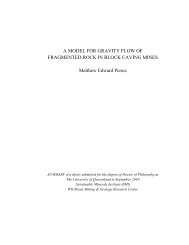ISSN : 2277-1328 (Online) - ISRM
ISSN : 2277-1328 (Online) - ISRM
ISSN : 2277-1328 (Online) - ISRM
You also want an ePaper? Increase the reach of your titles
YUMPU automatically turns print PDFs into web optimized ePapers that Google loves.
4 <strong>ISRM</strong> (India) Journal<br />
ratio, and therefore the material retained to bear cave loads<br />
changes almost exponentially.<br />
Fig. 1 : An example relation between crosscut spacing and<br />
extraction ratio (assuming all other dimensions are fixed)<br />
for a particular block cave extraction level design<br />
The capacity of this ‘system’ of pillars is further diminished<br />
by many factors. For deep caves critical considerations<br />
include:<br />
• Scale effects; the pillar scale strength is a small fraction<br />
of the laboratory scale strength, probably closer to<br />
the rock mass strength for most jointed rocks suitable<br />
for caving.<br />
• The very high extraction ratio. This well understood,<br />
but sometimes not fully accounted for. Many models<br />
do not simulate the extraction level excavations,<br />
instead using an ‘equivalent material’ approach that<br />
approximates the presence of extraction level tunnels<br />
using a softer material for the entire horizon. The<br />
problem with this approach is that it cannot account<br />
for the loss of confinement that occurs when the<br />
drawpoints and drawbells are mined nor the real impact<br />
on pillar loads. As the confinement is much reduced,<br />
so too is the strength of pillars even if there is no prior<br />
damage and if this is not recognised the capacity of<br />
the extraction level to bear load will be overestimated.<br />
At even minor levels of rock mass damage (i.e., prepeak)<br />
induced on the extraction level during<br />
undercutting,the effects of the reduction in confinement<br />
when drawpoints are extracted will be observable.<br />
• The centroid between extraction level crosscuts is not<br />
the location of the most important extraction level<br />
pillars cores. The real extraction level drawpoint pillar<br />
centroid is infact just a few metres from the extraction<br />
level crosscut, within the zone of influence of the<br />
extraction level crosscut if it is already in place as the<br />
undercut is mined.<br />
• Damage at the walls of pillars acts to diminish the<br />
‘effective’ area of the pillar even though the ‘future’<br />
pillar core may experience only minor or no damage.<br />
Poorly conditioned models with an inadequate type or<br />
insufficient number of elements will not capture this<br />
effect, nor will models with over-sized extraction steps.<br />
The most subtle of all of these points may be the loss of<br />
confinement that occurs on the extraction level when the<br />
drawpoints and drawbells are mined. It can explain why<br />
cave loads can still affect pillars which show only minor<br />
or moderate damage prior to extraction of the drawbells.<br />
The reason for the initial lack of damage (i.e., in advance<br />
of the undercut), will usually be the positive effects of<br />
confinement up until this point and the large crosscut<br />
spacing. Once the undercut has passed and drawbells<br />
and drawpoints are extracted, the loss of confinement<br />
can leads to an immediate loss in capacity. Since the<br />
cave loads havenot developed at that time, this capacity<br />
reduction may not even be noticed.<br />
Too often it is assumed that as the peak strength has not<br />
been exceeded prior to undercutting that the same confined<br />
triaxial strength remains after drawbell and drawpoint<br />
extraction, but the loss of confinement means that the<br />
effective capacity of a pillar from that point forward will be<br />
much reduced, apart from the effects of the very high<br />
extraction ratio.<br />
The effect of both combined is a step change reduction in<br />
capacity of the horizon to bear loads after the draw points<br />
and draw bells are extracted; the pillars are essentially,<br />
or almost only uniaxially loaded from that point on and<br />
the strength of a pillar, or its capacity can be halved or<br />
more even though it has been ‘destressed’ by undercutting<br />
and even though the rock is not in a residual state.<br />
These considerations lead to several pillar scenarios that<br />
must therefore be considered in any deep block cave:<br />
• Low deformation should be expected where the rock<br />
mass is sufficiently strong, only very minor or no<br />
damage develops on the extraction horizon before the<br />
undercut has passed, and the subsequent drop in<br />
confinement and loss of capacity (when the<br />
construction is completed) is small enough that future<br />
cave loads will be managed despite the high extraction<br />
ratio. The key positive factors are low enough cave<br />
load, the extraction ratio and the peak rock mass scale<br />
compressive strength.<br />
• Higher deformation should be expected at low enough<br />
strengths, or high enough abutment stresses,<br />
thatdamage on the extraction level at future pillar core<br />
locations occur during undercutting. The subsequent<br />
losses of confinement and the increasing extraction<br />
ratio does sufficiently reduce the capacity of the<br />
extraction horizon to bear future cave loads.The actual<br />
cave loads will determine the final state of damage.<br />
• In some circumstances, the rock may be so weak<br />
that it is damaged sufficiently at the abutment that a<br />
Volume 1 No. 2 July 2012




